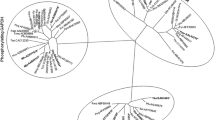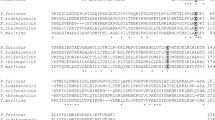Abstract
Thermoplasma acidophilum is a thermoacidophilic archaeon that grows optimally at 59°C and pH 2. Along with another thermoacidophilic archaeon,Sulfolobus solfataricus, it is known to metabolize glucose by the non-phosphorylated Entner-Doudoroff (nED) pathway. In the course of these studies, the specific activities of glyceraldehyde dehydrogenase and glycerate kinase, two enzymes that are involved in the downstream part of the nED pathway, were found to be much higher inT. acidophilum than inS. solfataricus. To characterize glycerate kinase, the enzyme was purified to homogeneity fromT. acidophilum cell extracts. TheN-terminal sequence of the purified enzyme was in exact agreement with that of Ta0453m in the genome database, with the removal of the initiator methionine. Furthermore, the enzyme was a monomer with a molecular weight of 49 kDa and followed Michaelis-Menten kinetics withK m values of 0.56 and 0.32 mM forDL-glycerate and ATP, respectively. The enzyme also exhibited excellent thermal stability at 70°C. Of the seven sugars and four phosphate donors tested, onlyDL-glycerate and ATP were utilized by glycerate kinase as substrates. In addition, a coupled enzyme assay indicated that 2-phosphoglycerate was produced as a product. When divalent metal ions, such as Mn2+, Co2+, Ni2+, Zn2+, Ca2+, and Sr2+, were substituted for Mg2+, the enzyme activities were less than 10% of that obtained in the presence of Mg2+. The amino acid sequence ofT. acidophilum glycerate kinase showed no similarity withE. coli glycerate kinases, which belong to the first glycerate kinase family. This is the first report on the biochemical characterization of an enzyme which belongs to a member of the second glycerate kinase family.
Similar content being viewed by others
References
Verhees, C. H., S. W. M. Kengen, J. E. Tuininga, G. I. Schut, M. W. W. Adams, W. M. De Vos, and J. van der Oost (2003) The unique features of glycolytic pathways in Archaea.Biochem. J. 375: 231–246.
Lamble, H. J., N. I. Heyer, S. D. Bull, D. W. Hough, and M. J. Danson (2003) Metabolic pathway promiscuity in the archaeonSulfolobus solfataricus revealed by studies on glucose dehydrogenase and 2-keto-3-deoxygluconate aldolase.J. Biol. Chem. 278: 34066–34072.
De Rosa, M., A. Gambacorta, B. Nicolaus, P. Giardina, E. Poerio, and V. Buonocore (1984) Glucose metabolism in the extreme thermoacidophilic archaebacteriumSulfolobus solfataricus.Biochem. J. 224: 407–414.
Budgen, N. and M. J. Danson (1986) Metabolism of glucose via a modified Entner-Doudoroff pathway in the thermoacidophilic archaebacteriumThermoplasma acidophilum.FEBS Lett. 196: 207–210.
Smith, L. D., N. Budgen, S. J. Bungard, M. J. Danson, and D. W. Hough (1989) Purification and characterization of glucose dehydrogenase form the thermoacidophilic archaebacteriumThermoplasma acidophilum.Biochem. J. 261: 973–977.
Giardina, P., M. G. De Biasi, M. De Rosa, A. Gambacorta, and V. Buonocore (1986) Glucose dehydrogenase from the thermoacidophilic archaebacteriumSulfolobus solfataricus.Biochem. J. 239: 517–522.
Kim, S. H. and S. B. Lee (2005) Identification and characterization ofSulfolobus solfataricus D-gluconate dehydratase: A key enzyme in the nonphosphorylated Entner-Doudoroff pathway.Biochem. J. 387: 271–280.
Lamble, H. J., C. C. Milburn, G. L. Taylor, D. W. Hough, and M. J. Danson (2004) Gluconate dehydratase from the promiscuous Entner-Doudoroff pathway inSulfolobus solfataricus.FEBS Lett. 576: 133–136.
Buchanan, C. L., H. Connaris, M. J. Danson, C. D. Reeve, and D. W. Hough (1999) An extremely thermostable aldolase fromSulfolobus solfataricus with specificity for non-phosphorylated substrates.Biochem. J. 343: 563–570.
Jung, J. H. and S. B. Lee (2006) Identification and characterization ofThermoplasma acidophilum glyceraldehyde dehydrogenase: a new class of NADP+-specific aldehyde dehydrogenase.Biochem. J. 397: 131–138.
Cheek, S., K. Ginalski, H. Zhang, and N. V. Grishin (2005) A comprehensive update of the sequence and structure classification of kinases.BMC Struct. Biol. 5: 6.
Chistoserdova, L. and M. E. Lidstrom (1997) Identification and mutation of a gene required for glycerate kinase activity from a facultative methylotroph,Methylobacterium extorquens AM1.J. Bacteriol. 179: 4946–4948.
Crouzet, P. and L. Otten (1995) Sequence and mutational analysis of a tartrate utilization operon fromAgrobacterium vitis.J. Bacteriol. 177: 6518–6526.
Park, C. B. and S. B. Lee (1998) Ammonia production from yeast extract and its effect on growth of hyperthermophilic archaeonSulfolobus solfataricus.Biotechnol. Bioprocess Eng. 3: 115–118.
Park, C. B. and S. B. Lee (1999) Cultivation of the hyperthermophilic archaeonSulfolobus solfataricus in low salt media.Biotechnol. Bioprocess Eng. 4: 21–25.
Park, C. B. and S. B. Lee (1999) Inhibitory effect of mineral ion accumulation on high density growth of the hyperthermophilic archaeonSulfolobus solfataricus.J. Biosci. Bioeng. 87: 315–319.
Park, C. B., S. B. Lee, and D. D. Y. Ryu (2001)l-Pyroglutamate spontaneously formed froml-glutamate inhibits growth of the hyperthermophilic archaeonSulfolobus solfataricus.Appl. Environ. Microbiol. 67: 3650–3654.
Jung, J. H. and S. B. Lee (2005) Identification and characterization ofThermoplasma acidophilum 2-keto-3-deoxy-D-gluconate kinase: a novel enzyme essential for the partially non-phosphorylated Entner-Doudoroff pathway.Biotechnol. Bioprocess Eng. 10: 535–539.
S. Kim and S. B. Lee (2006) Characterization ofSulfolobus solfataricus 2-keto-3-deoxy-D-gluconate kinase in the modified Entner-Doudoroff pathway.Biosci. Biotechnol. Biochem. 70: 1308–1316.
Doughty, C. C., J. A. Hayashi, and H. L. Guenther (1966) Purification and properties ofD-glycerate 3-kinase fromEscherichia coli.J. Biol. Chem. 241: 568–572.
Ornston, M. K. and L. N. Ornston (1969) Two forms ofD-glycerate kinase inEscherichia coli.J. Bacteriol. 97: 1227–1233.
Hubbard, B. K., M. Koch, D. R. Palmer, P. C. Babbitt, and J. A. Gerlt (1998) Evolution of enzymatic activities in the enolase superfamily: characterization of the (D)-glucarate/galactarate catabolic pathway inEscherichia coli.Biochemistry 37: 14369–14375.
Cusa, E., N. Obradors, L. Baldoma, J. Badia, and J. Aguilar (1999) Genetic analysis of a chromosomal region containing genes required for assimilation of allantoin nitrogen and linked glyoxylate metabolism inEscherichia coli.J. Bacteriol. 181: 7479–7484.
Monterrubio, R., L. Baldoma, N. Obradors, J. Aguilar, and J. Badia (2000) A common regulator for the operons encoding the enzymes involved inD-galactarate,D-glucarate, andD-glycerate utilization inEscherichia coli.J. Bacteriol. 182: 2672–2674.
Van Schaftingen, E. (1989)D-glycerate kinase deficiency as a cause ofD-glyceric aciduria.FEBS Lett. 243: 127–131.
Yoshida, T., K. Yamaguchi, T. Hagishita, T. Mitsunaga, A. Miyata, T. Tanabe, H. Toh, T. Ohshiro, M. Shimao, and Y. Izumi (1994) Cloning and expression of the gene for hydroxypyruvate reductase (D-glycerate dehydrogenase) from an obligate methylotrophHyphomicrobium methylovorum GM2.Eur. J. Biochem. 223: 727–732.
Author information
Authors and Affiliations
Corresponding author
Rights and permissions
About this article
Cite this article
Noh, M., Jung, J.H. & Lee, S.B. Purification and characterization of glycerate kinase from the thermoacidophilic archaeonThermoplasma acidophilum: An enzyme belonging to the second glycerate kinase family. Biotechnol. Bioprocess Eng. 11, 344–350 (2006). https://doi.org/10.1007/BF03026251
Received:
Accepted:
Issue Date:
DOI: https://doi.org/10.1007/BF03026251




